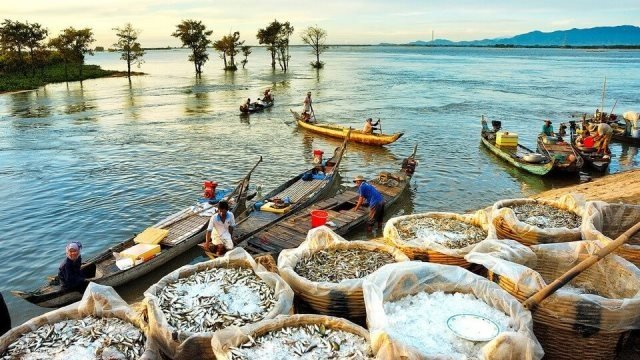


|
This year, the season started two weeks early, with the water
level 30-50 centimetres higher than usual. Currently, most of the rice fields
have been harvested. Floodwater has covered residential areas, roads and
fields in Dong Thap and Long An province, and the vast fields now become busy
with boats, which are used by the locals both as a major means of transport
and a means to catch fish.
Among the major sources of income for Mekong Delta residents
while surrounded by the rising water are linh fish
(Henicorhynchus), crabs, and snails.
A kilogramme of linh fish can be sold for
VND60,000 in the early flood season and VND40,000 during the peak time. The fish
are collected by traders and restaurants and they can be resold for triple
after processing.
On their boats, locals sell various specialties of "floating
season”, such as lotus stems, water lilies, dien dien flowers,
and other sweet products made from sugar palm trees.
Young farmer Huy was swimming to the corn field, which is
flooded under 1.5-2 metres of water, in order to collect corn stalks, which
can be used as food for oxen or a source of fertiliser.
He said that his family produces only two rice crops a year and
they are off during the flood season to let the farmland "relax” and conserve
nutrition for new crops. When the water level is low, the family cultivate
fast growing vegetables. If the water level is high, Huy earns income from
casting a fishing net and collecting dien dien flowers.
The Mekong Delta region’s cuisine is renowned for many
appetising dishes made from local specialties and using unique cooking
methods, such as chicken and rice steamed in lotus leaves, straw roasted
fish, braised duck with fermented tofu, salad of sau dau leaves
and seasoned dried fish.
"Floating season” is a good time for foodies coming to the
Mekong Delta to taste dishes made from the signature vegetables and herbs of
the season, including hot pot of linh fish and dien
dien flowers, crispy fried linh fish, tiny shrimp
fried with dien dien flowers.
Dien dien flowers and lotus stems, both fruitful when the floodwaters are
rising, are the perfect match for making salads and hot pots.
Along the streets in Tan Hung district, Long An province,
travellers can buy dried lotus seeds, fresh lotus seed pods, lotus stems, and
lotus seed milk.
With only VND25,000 (US$1), one can buy around 20 lotus seed
pods, in which lotus seed can be used to cook elegant sweet soup with palm
sugar.
On the way from the downtown of Tinh Bien district to the Nui
Cam tourism site in An Giang province, there are dozens of street stalls
selling ‘banh xeo’, a kind of crispy pancake served with selected wild
leaves and vegetables.
Collecting wild leaves and vegetables as ingredients for the
stalls provides a good source of income for local residents during flood
season.
Gourmets having a tasty dish of banh xeo can
learn more about the names and uses of more than 30 leaves and herbs served
with the dish.
Meanwhile, the aromatic, juicy linh fish, one
of the southerners' favourite fish, is used for grilling and hot pot. A hot
pot of linh fish is a colourful harmony of taste and colours
with red tomatoes and broth standing out with the yellow dien
dien flowers and slices of pineapples, and green onion and
vegetables.
|
Source: NDO